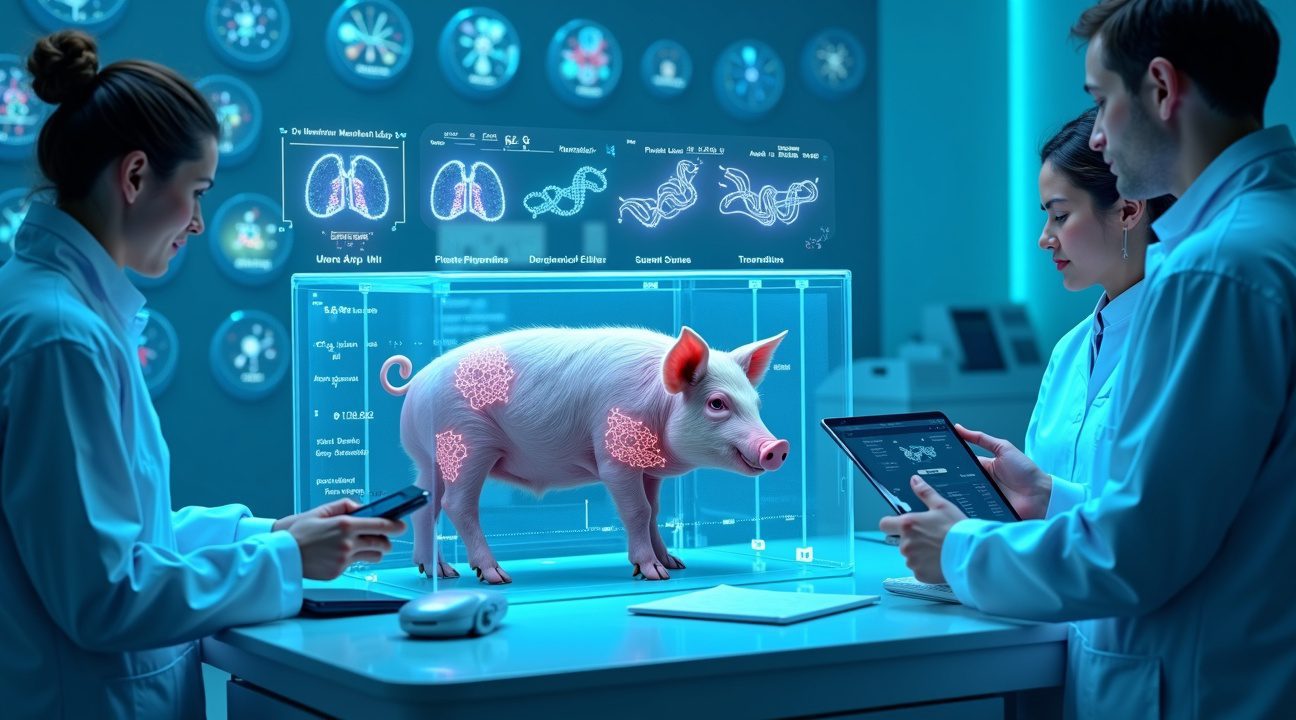Chinese scientists have achieved a groundbreaking milestone in medical history by performing the world’s first pig-to-human lung transplant, sparking new hope for the future of xenotransplantation.
Breakthrough in Xenotransplantation
In a major advancement for medical science, a team of Chinese researchers successfully transplanted a genetically modified pig lung into a brain-dead human recipient. Remarkably, the transplanted lung functioned for nine days, performing crucial gas exchange tasks before immune rejection brought the experiment to an end. This marks the first time such a lung transplant has been achieved using an animal donor and is seen as a significant milestone in solving the global shortage of donor organs.
How the Organ Functioned
Throughout the nine-day trial, the pig lung continuously carried out its vital role in gas exchange. This information offers invaluable insight into cross-species transplantation and sets the groundwork for future living patient trials.
Genetic Engineering for Compatibility
Using CRISPR gene-editing technology, scientists modified the pig donor with six key genetic changes:
- Three pig genes were removed to reduce triggering of human immune responses
- Three human genes were added to enhance organ compatibility and minimize early rejection
Unexpected Discoveries in Immune Response
The experiment revealed surprising patterns in immune reaction. While typical transplants often result in severe tissue inflammation, researchers observed:
- Minimal rejection during the initial three days, which are usually the most critical
- Unexpected reduction in tissue damage by day nine, challenging traditional models of cross-species immune rejection
Lung Transplants: A Unique Challenge
Lung transplantation remains among the most difficult organ replacements in modern medicine because:
- The lungs have a highly complex anatomy
- They remain in constant contact with the external environment, making them highly susceptible to infection
- The tissue is particularly sensitive to immune attack
A Step Toward Solving the Organ Shortage Crisis
This landmark achievement is seen as a promising step toward addressing the worldwide shortage of transplantable organs. However, significant hurdles still need to be addressed, including:
- Overcoming long-term immune rejection
- Ensuring ethical compliance for future human trials
- Developing scalable and safe protocols for clinical applications
For more detailed scientific reporting, you can explore the full coverage in this Nature article on the pig-to-human lung transplant.
World’s First Pig-to-Human Lung Transplant Keeps Brain-Dead Patient Breathing for Nine Days
Chinese scientists made medical history in May 2024 when they successfully transplanted a lung from a genetically modified pig into a 39-year-old brain-dead man at the First Affiliated Hospital of Guangzhou Medical University. This groundbreaking xenotransplantation experiment represents a significant milestone in organ transplant research, offering hope for the thousands of patients currently waiting for compatible human organs.
Functional Success Despite Ultimate Rejection
The transplanted pig lung demonstrated remarkable functionality for nine consecutive days, successfully performing critical gas exchange functions including oxygenation and carbon dioxide removal. During the initial three days, medical teams observed no signs of immune rejection, infection, or graft failure — a promising indicator that genetic modifications to the donor pig had effectively reduced immediate compatibility issues.
I find it particularly noteworthy that the lung survived the hyperacute rejection phase, which typically occurs within minutes to hours after transplantation when incompatible organs are involved. This achievement suggests that the genetic modifications made to the pig were effective in overcoming one of the most significant barriers in cross-species organ transplantation.
Immune Response and Experimental Conclusion
Despite the initial success, the pig lung eventually succumbed to immune attack after nine days. The human immune system ultimately recognized the foreign tissue and mounted a response that compromised the organ’s function. Medical researchers had anticipated this outcome, as current immunosuppressive protocols aren’t yet optimized for xenotransplantation procedures.
The experiment concluded at the family’s request, marking the end of this historic procedure. While the ultimate rejection was expected, the nine-day survival period provided invaluable data about how genetically modified pig organs function in human bodies. This research builds upon previous successful scientific breakthroughs that have pushed the boundaries of what’s medically possible.
The implications of this research extend far beyond a single experiment. With severe organ shortages affecting patients worldwide, xenotransplantation could potentially provide an unlimited supply of organs for transplantation. The successful gas exchange demonstrated by the pig lung suggests that with further genetic modifications and improved immunosuppressive protocols, pig-to-human lung transplants might become a viable treatment option for patients with end-stage lung disease.
How Scientists Created the Gene-Edited Pig Lung for Human Transplantation
The groundbreaking transplant relied on a specially engineered pig lung developed by Chengdu Clonorgan Biotechnology using CRISPR gene-editing technology. Scientists modified the donor pig through six strategic genetic alterations designed to make the organ more compatible with human biology.
The Six-Step Genetic Modification Process
The gene-edited pig underwent a carefully planned modification process that involved both deletion and addition of specific genes:
- Three pig genes were completely removed to reduce the likelihood of immune system detection
- Three human genes were inserted to help the transplanted lung integrate better with human physiology
- Each modification targeted specific immune response pathways to minimize rejection risk
- The CRISPR technology allowed for precise editing without affecting other genetic functions
This dual approach is particularly fascinating because it addresses transplant rejection from both directions — making the pig lung less recognizable as foreign tissue while simultaneously giving it human-like characteristics.
The research team took extraordinary precautions to ensure ethical compliance throughout the process. They conducted four separate assessments to confirm the recipient’s brain death status before proceeding with the experimental surgery. Family members provided informed consent after receiving comprehensive information about the procedure’s experimental nature and objectives.
This Chinese research team designed the study as a proof of concept rather than an immediate clinical solution for living patients. The primary goals focused on collecting fundamental data about immune responses between genetically modified pig organs and human recipients. Scientists wanted to understand how the modified lung would behave in a human body environment and whether the genetic modifications would successfully reduce rejection mechanisms.
The experimental framework allows researchers to observe organ function without the ethical complexities of using living patients. Brain-dead recipients provide an ideal testing environment because their bodies maintain basic physiological functions while eliminating concerns about patient outcomes. This approach enables scientists to gather critical data about tissue compatibility, immune responses, and surgical techniques that will inform future clinical applications.
The CRISPR modifications represent years of research into identifying which genetic differences create the biggest barriers between pig and human organ compatibility. By targeting these specific genetic markers, scientists hope to eventually create pig organs that function seamlessly in human recipients, potentially solving the critical organ shortage that affects thousands of patients worldwide.

Why Lung Transplants Are Medicine’s Toughest Challenge
Lung transplantation stands apart as the most challenging form of organ transplant surgery that medical professionals face today. The intricate structure of human lungs presents unique obstacles that don’t exist with other organs. Unlike hearts or kidneys, lungs contain an extraordinary density of blood vessels and delicate air sacs that must maintain perfect function for breathing to occur.
This complex anatomy makes lungs exceptionally vulnerable to immune reactions when transplanted from one person to another. The body’s natural defense system recognizes the new organ as foreign tissue and launches an aggressive attack. Blood clotting becomes a major concern during and after surgery, as the numerous tiny vessels within lung tissue can easily become blocked. Tissue damage occurs more readily in lungs than in other transplanted organs, often leading to complications that threaten patient survival.
The global statistics paint a sobering picture of this medical challenge. In 2024, surgeons performed 8,236 lung transplants worldwide, representing a 6% increase from the previous year. While this growth shows progress in surgical techniques and patient care, the numbers fall drastically short of actual need. Tens of thousands of patients currently wait for lung transplants, with many dying before suitable donor organs become available.
Breaking New Ground in Xenotransplantation
Medical researchers have turned to xenotransplantation as a potential solution to the organ shortage crisis. Previous groundbreaking attempts have shown both promise and limitations in this field:
- Pig-to-human liver transplants have been conducted in China, offering valuable insights into cross-species organ compatibility
- Heart xenografts from pigs to humans have been performed in the United States, advancing our understanding of cardiac xenotransplantation
- Kidney transplants from pigs to humans have provided crucial data about immune responses and organ function across species
The Chinese lung xenotransplant experiment marks the first reported attempt to transplant pig lungs into a human recipient. This milestone represents years of preparation and research into making pig organs compatible with human physiology. Scientists have genetically modified pigs to reduce the likelihood of immune rejection, though significant challenges remain.
Clinical trials currently underway in the United States continue to push the boundaries of pig organ transplants. These studies focus on refining surgical techniques, improving immunosuppressive protocols, and identifying the best candidates for xenotransplantation procedures. Each trial contributes valuable data that brings this technology closer to becoming a viable treatment option for patients facing organ failure.
The lung xenotransplantation field faces unique hurdles that distinguish it from other organ transplant research. Lungs must immediately begin the critical function of gas exchange upon transplantation, leaving no room for gradual adaptation. The constant exposure to air and potential contaminants makes transplanted lungs more susceptible to infection than organs that remain sealed within the body cavity.
Research into genetic modifications of donor pigs continues to evolve, with scientists working to eliminate specific proteins that trigger human immune responses. These efforts aim to create organs that the human body will accept more readily, reducing the need for aggressive immunosuppressive medications that carry their own serious risks.
The success of lung xenotransplantation could transform treatment options for patients with end-stage lung disease. Conditions like chronic obstructive pulmonary disease, pulmonary fibrosis, and severe COVID complications often progress to the point where transplantation becomes the only viable treatment option. Current waiting times for human donor lungs frequently exceed the patient’s remaining lifespan, making xenotransplantation a potentially life-saving alternative.
The path forward requires careful balance between innovation and safety. Each experimental procedure provides crucial information about how pig organs function in human recipients, informing future protocols and surgical approaches that may eventually save countless lives.

Critical Immune Responses Revealed During Nine-Day Experiment
I’ve examined the fascinating immune dynamics that unfolded during this groundbreaking nine-day xenotransplantation study. The research team meticulously tracked how the human immune system responded to the pig lung tissue, revealing unexpected patterns that could reshape future transplant approaches.
Early Immune Recognition and Antibody Response
The transplanted lung faced immediate challenges from the recipient’s immune system. By day three, scientists detected clear signs of antibody-mediated damage targeting the foreign tissue. This early response pattern continued through day six, confirming that immune barriers remain a significant hurdle in cross-species organ transplantation.
These antibody attacks represent the body’s natural defense mechanism against foreign proteins and cellular structures. The immune system recognized the pig lung tissue as non-self and mounted a coordinated response to eliminate what it perceived as a threat. This reaction mirrors similar patterns observed in traditional human-to-human transplants, though the intensity often proves more severe in xenogeneic procedures.
Unexpected Recovery Patterns and Complex Interactions
What surprised researchers most was the dramatic shift observed by day nine. Tissue injury responses actually decreased rather than continuing to escalate, suggesting that immune interactions prove far more complex than initially anticipated. This unexpected turn challenges conventional understanding of how human immune systems respond to pig organs over extended periods.
Several factors might explain this surprising development:
- Immune system exhaustion after prolonged activation
- Adaptive responses that modulate initial rejection mechanisms
- Cellular accommodation processes that reduce tissue damage
- Modified inflammatory pathways that shift from acute to chronic responses
The research provides crucial insights into xenogeneic lung tissue compatibility that could influence future clinical strategies. Scientists now have concrete evidence of how human immune systems react to pig organs beyond the critical first 72 hours. This data becomes essential for developing targeted immunosuppressive protocols and genetic modifications that might improve transplant survival rates.
This proof-of-concept study demonstrates that pig lungs can function within human physiological systems, even when facing active immune responses. The findings suggest that with proper preparation and immune management, xenotransplantation might offer viable solutions for patients facing organ shortages. However, the research also underscores the complexity of immune barriers that still require significant scientific advances.
Clinical translation of these findings will depend on addressing the antibody-mediated damage observed in early stages while capitalizing on the apparent stabilization seen later in the experiment. Future studies must explore whether similar patterns emerge in longer-term experiments and living recipients. The work represents a critical step forward in understanding human-pig organ compatibility, though substantial research remains before clinical applications become reality.
The nine-day timeline provides valuable baseline data for future xenotransplantation protocols. Scientists can now design interventions targeting specific timepoints when immune responses peak or stabilize. This temporal understanding of immune dynamics offers new opportunities for therapeutic intervention that could dramatically improve patient outcomes in future xenogeneic lung transplant procedures.
Major Hurdles Still Stand Before Pig Lungs Can Save Human Lives
Several significant challenges remain before pig lung transplantation can become a viable solution for patients with end-stage pulmonary disease. The recent breakthrough represents just the beginning of a complex journey that requires substantial advances across multiple scientific disciplines.
Critical Technical Barriers to Clinical Implementation
The current research demonstrates promise, but several key obstacles must be overcome. First, extending organ survival beyond the nine-day mark achieved in the initial study remains a primary concern. While nine days represents remarkable progress, clinical transplants require organs that function for years, not days.
Preventing antibody-mediated rejection presents another formidable challenge. The human immune system recognizes pig tissue as foreign and launches aggressive attacks that current immunosuppressive protocols cannot fully control. Gene-editing techniques must be refined to create pig organs that more closely match human genetic compatibility. Scientists need to identify and modify additional pig genes that trigger immune responses while preserving essential organ function.
Ensuring lungs remain viable after patients are removed from life-support systems adds another layer of complexity. The controlled environment of mechanical ventilation differs drastically from natural breathing patterns. Future research must demonstrate that transplanted pig lungs can maintain adequate oxygenation and carbon dioxide removal without artificial support.
Immune barriers represent perhaps the most significant hurdle. Unlike other organs, lungs face constant exposure to environmental pathogens and allergens. This continuous challenge means transplanted pig lungs must not only avoid rejection but also maintain normal defensive functions. The delicate balance between immune tolerance and protection requires precise calibration that current technology hasn’t achieved.
Genetic compatibility issues extend beyond simple rejection prevention. Pig and human physiology differ in fundamental ways that affect lung function, including breathing patterns, oxygen transport, and cellular metabolism. These differences could lead to complications that don’t become apparent until months or years after transplantation.
Developing reliable preclinical data presents its own challenges. Animal models can’t fully replicate the complex interactions between transplanted organs and human physiology. Researchers must design comprehensive studies that evaluate long-term outcomes while addressing safety concerns that regulatory agencies will scrutinize.
Ethical considerations add another dimension to the research timeline. Questions about animal welfare, consent protocols for brain-dead patients, and resource allocation require careful examination. Religious and cultural perspectives on using animal organs in humans vary significantly across populations, potentially affecting acceptance rates even if technical hurdles are overcome.
The path from laboratory success to clinical practice typically spans decades for complex procedures like organ transplantation. Regulatory approval processes demand extensive safety data that can only be gathered through years of careful study. Each stage of development must demonstrate not just efficacy but also acceptable risk profiles compared to existing treatments.
Manufacturing and quality control systems for genetically modified pig organs don’t currently exist at the scale needed for widespread clinical use. Creating specialized facilities that can produce transplant-ready organs while maintaining strict safety standards requires substantial investment and infrastructure development.
Financial barriers also influence research progress. The costs associated with developing xenotransplantation exceed those of traditional medical research due to the need for specialized facilities, genetically modified animals, and extended study periods. Securing consistent funding for long-term projects remains challenging in competitive research environments.
Despite these obstacles, the potential benefits drive continued investigation. Organ shortages affect thousands of patients annually, and pig lungs could eventually address this critical need. However, transitioning from promising laboratory results to safe, effective clinical treatments requires addressing each of these challenges systematically. The timeline for achieving clinical readiness likely extends years into the future, but each successful experiment brings researchers closer to that goal.
What This Breakthrough Means for Thousands Waiting for Lung Transplants
This groundbreaking xenotransplantation study represents a crucial proof-of-concept that could transform organ transplantation forever. Gene-edited pig lungs demonstrated functional capacity in a human recipient, marking the first successful attempt of its kind. The achievement provides concrete evidence that cross-species organ transplantation might eventually become a viable solution for addressing the severe organ shortage crisis.
Addressing the Critical Organ Shortage
Currently, more than 100,000 Americans wait for organ transplants, with approximately 1,500 specifically needing lung transplants according to recent data. The organ shortage represents one of medicine’s most pressing challenges, as only a fraction of patients receive transplants before their conditions become terminal. This pig-to-human lung transplant offers a potential pathway to dramatically expand the available organ supply, similar to how researchers find groundbreaking discoveries that challenge existing limitations.
Gene-editing technology allows scientists to modify pig organs, removing problematic proteins that typically trigger immediate rejection in human recipients. Pigs offer several advantages as organ donors:
- Their organs are similar in size to human organs
- They mature quickly
- They can be bred in controlled environments
The successful functioning of the transplanted lung demonstrates that these genetic modifications work as intended, bringing xenotransplantation closer to clinical reality.
The Path from Laboratory to Lifesaving Treatment
Despite this breakthrough, significant hurdles remain before pig organs can save human lives routinely. Clinical translation requires extensive safety testing, regulatory approval, and refinement of surgical techniques. Scientists must address long-term compatibility issues, ensure consistent organ quality, and develop protocols for preventing complications unique to cross-species transplantation.
The timeline for bringing this technology to patients remains uncertain, but the successful proof-of-concept accelerates research efforts significantly. Multiple research teams worldwide are now pursuing similar studies, building on these initial findings to improve outcomes and safety profiles. Each successful experiment brings the medical community closer to offering hope for patients who currently face limited treatment options.
This achievement parallels other scientific breakthroughs that initially seemed impossible but eventually revolutionized medicine. The transplanted pig lung functioned properly, processing oxygen and removing carbon dioxide as expected, proving that species barriers in organ transplantation can be overcome through careful genetic engineering and surgical precision.
For thousands currently waiting for lung transplants, this research offers genuine hope for future treatment options. While immediate clinical applications remain years away, the successful demonstration that pig lungs can function in humans represents a fundamental shift in transplant medicine’s possibilities. The breakthrough validates decades of xenotransplantation research and establishes a foundation for developing reliable, scalable organ alternatives that could save countless lives.

Sources:
Live Science – First-ever pig-to-human lung transplant attempted in brain-dead person in China
Science – First pig lung survives and functions briefly in person
STAT – First lung transplant from gene-edited pig performed in China
Nature – First pig-to-human lung transplant keeps brain-dead patient alive for nine days
Pulmonology Advisor – Pig lung transplanted into man for 9 days in groundbreaking study
Nature Medicine – Pig lung transplanted into human – a breakthrough in xenotransplantation


